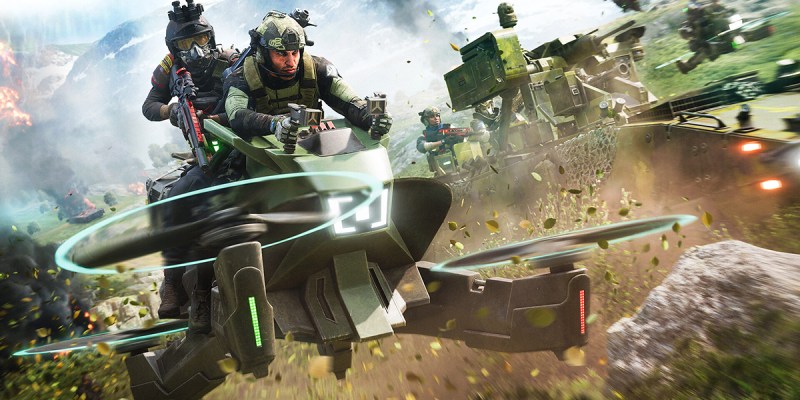As we await news about the next Battlefield (which may or may not arrive this year), I’ve been playing a lot of the now-healthy Battlefield 2042, and I think I might have figured out what’s been missing from recent entries.
As many hours as I’ve put into the last three Battlefield installments – 1, V, and 2042 – it hasn’t escaped me that the series got kind of lost trying to chase the same type of success that Call of Duty effortlessly farms every year. Mind you, DICE has never forgotten that Battlefield is all about fictional and historical warfare on a large scale without going “full simulation” coupled with stunning audiovisual presentations, but it feels like all the new tech advancements that have traditionally separated the series from the competition and directly shaped the gameplay were eventually “frozen” in favor of simply swapping the settings and trying to go bigger and shinier just for the sake of it.

Battlefield still is markedly different from Call of Duty, and the latter’s weak efforts to push large-scale game modes served to highlight just how unique DICE’s renowned FPS series is… or at least used to be. Almost every alternative to Battlefield feels either too janky or needlessly obtuse and unfriendly to newcomers. This has allowed the IP to wade through its slower years and many crises, but how long will it be before its veteran community has truly had enough?
Zampella seems to believe it’s time to make Battlefield feel like golden era Battlefield, which most players would argue was the Bad Company 2 – BF3/4 stretch. I personally believe this has nothing to do with the modern-day setting. After all, BF2042 barely feels futuristic and even included a fair amount of content from those games through Portal. Instead, it’s about regaining the “sandbox magic” the franchise is known for, and that includes pushing the tech to shape the moment-to-moment experience.
In the aforementioned “golden era” titles, most maps felt unique because they had a personality that went beyond their geographical locations and basic layouts. The squad tactics of Grand Bazaar had nothing to do with Caspian Border’s, for example. On top of that, the destruction of entire chunks of the environments actually played a huge role in how battles could go. Nowadays, it feels like the handful of destructible elements in 2042 maps are just there.

Unsurprisingly, the remastered BC2 and BF3 maps in the Portal portion of DICE’s latest are the exception to the trend. They’ve mostly retained the “reshapable sandbox” DNA that made them so good back in the day. Small houses and huts can be utterly demolished, and all the destruction that can happen actually has an effect on the battle. Even when 2042 eventually received a traditional class system and countless other QoL improvements, most of its main-dish maps still lack the juice to become classics despite some attempts at recovering the “Levolution” events that made BF4 special.
Looking back at past entries, I strongly believe Battlefield games are only as good as the median of their maps, which is why the awkwardly-tuned BF1 has retained so much of its player base over the years; the gunplay isn’t exactly solid, but the vibes are fantastic, and most of the maps actually look (and behave) like war-torn battlefields.
All these reflections on what worked and what didn’t gel together, which are shared by a huge part of the community, lead us to the conclusion that the next Battlefield might be a creatively safe retread of BF3 and 4, which could potentially sell like hotcakes. The trick, however, won’t fully work unless there’s some serious planning and work put into the maps. If we revisit the early months of 2042, the pressing complaints about the state of the game had to do with the underbakedness of the launch maps. Going into a new game, DICE simply cannot screw that part of the core experience up again.

Of course, all the encouraging words coming from Zampella and other creative leads, as well as the fact several studios are working on the next generation of Battlefield, won’t amount to much if EA remains obsessed with the endangered live service model that’s partially responsible for making recent Battlefield entries feel kind of rushed. With tons of resources going into cosmetics and limited-time events, maps have seldom reached the heights of the series’ best and most enduring combat zones (though there have been very notable exceptions).
This isn’t me saying the franchise should return to the traditional DLC model, as that instantly put an expiration date on most maps and split the community apart. However, the priorities should be refocused. Most FPS players don’t play Battlefield looking for the same competitive thrills they can constantly get in Call of Duty and Fortnite. For example, trying to outperform those two behemoths of the genre in the battle royale arena feels like a lost battle. Hazard Zone completely killed that idea, I think. Boxing the updates and content drops into seasons also feels counterproductive when you look at how the core player base has interacted with Battlefield games over the years (playing them casually instead of making them a second job).
I might be wrong about the entire business model angle, as 2042 has surpassed the life cycle of V already (maybe a sign that a new game isn’t coming this year) and doesn’t seem to be ending its live service anytime soon. But I’m adamant that the series’ own internal battle is one for its soul. The next Battlefield will make or break DICE, and I’d rather be impressed by what I’m allowed to do besides shooting than shiny path-traced reflections.
